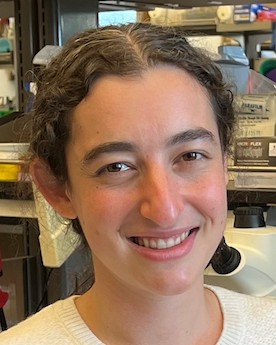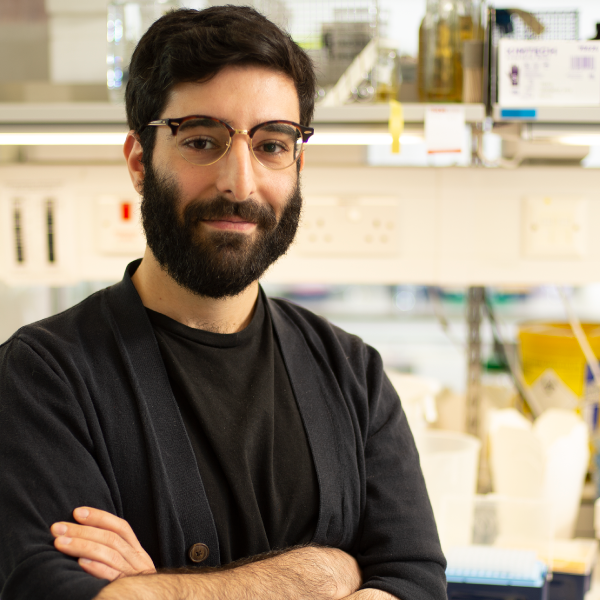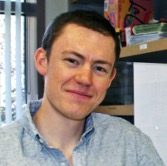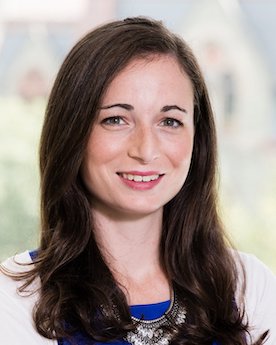
University of California, Berkeley
Appointed in 2023
Read more
University of California, Berkeley
Appointed in 2023
Aging is a complex physiological process coordinated across tissues within an organism. Loss of protein homeostasis is a hallmark of aging, yet it is not understood why dysregulation in protein synthesis occurs, and if this dysregulation drives aging pathologies. Dr. Naomi Genuth will investigate these questions in Dr. Andrew Dillin’s lab at the University of California, Berkeley. Dr. Genuth will use C. elegans to visualize protein synthesis patterns in vivo in different tissues during the aging process. Ultimately, Genuth aims to define the molecules that contribute to dysregulation of protein synthesis and see whether manipulation of these molecules can delay and/or prevent the aging process. Dr. Genuth’s research will improve our understanding of changes in protein synthesis during aging at the molecular, cellular, and organismal levels, and may reveal new therapeutic strategies for aging pathologies.
As a Ph.D. student in Dr. Maria Barna’s lab at Stanford University, Genuth investigated the role of translational regulation in gene expression. Specifically, she developed a quantitative roadmap of how ribosome composition changes during human embryonic stem cell differentiation. Dr. Genuth will now investigate protein synthesis during aging in Dr. Dillin‘s lab.


Max-Planck Institute
Appointed in 1971


Princeton University
Appointed in 1982


National Institutes of Health
Appointed in 1974


Stanford University
Appointed in 1991

MRC Laboratory of Molecular Biology
Appointed in 2021
Read more
MRC Laboratory of Molecular Biology
Appointed in 2021
Telomeres are repetitive nucleoprotein structures that protect the ends of linear eukaryotic chromosomes. Despite their importance, telomeres shorten at each round of cellular division due to an inherently incomplete replication process at DNA ends. This poses a threat to genome stability. The telomerase complex extends the telomeric repeats by processively copying from an internal template sequence, thereby counterbalancing telomere shortening. The action of telomerase at the telomeres is highly regulated in the cell. The current evidence indicates that a protein complex called shelterin orchestrates telomerase recruitment and activity at the telomeres. In mammals, shelterin is a six-subunit complex that binds telomeric DNA repeats and recruits telomerase through its TPP1 subunit, which assembles as a heterodimer with POT1. TPP1-POT1 not only recruit telomerase, but also stimulates its processivity. Stimulation and recruitment by shelterin are essential for telomerase function in vivo, yet the structural basis of telomerase-shelterin interactions and shelterin-mediated telomerase processivity remains elusive. We determined the cryo-EM structures of telomeric DNA-bound telomerase in complex with TPP1 and with TPP1-POT1 at 3.2 Å and 3.9 Å resolution, respectively. These structures define the molecular interactions between telomerase and TPP1-POT1 required for telomerase recruitment to telomeres. The interaction with TPP1-POT1 stabilizes the DNA, revealing an unexpected path exiting the active site and a conserved DNA anchor site on telomerase, which is important for telomerase processivity. Overall, our findings provide important insights into telomerase recruitment to telomeres and set a framework for future studies on telomerase regulation by shelterin.

Carnegie Institute for Science
Appointed in 2011
Read more
Carnegie Institute for Science
Appointed in 2011

Salk Institute for Biological Studies
Appointed in 2002
Read more
Salk Institute for Biological Studies
Appointed in 2002

Harvard University Medical School
Appointed in 2002
Read more
Harvard University Medical School
Appointed in 2002

California Institute of Technology
Appointed in 2012
Read more
California Institute of Technology
Appointed in 2012

University of California, Berkeley
Appointed in 1989
Read more
University of California, Berkeley
Appointed in 1989

Cold Spring Harbor Laboratory
Appointed in 2002
Read more
Cold Spring Harbor Laboratory
Appointed in 2002

University of Wisconsin, Madison
Appointed in 1984
Read more
University of Wisconsin, Madison
Appointed in 1984

University of California, San Francisco
Appointed in 2019
Read more
University of California, San Francisco
Appointed in 2019

University of Washington, Seattle
Appointed in 1978
Read more
University of Washington, Seattle
Appointed in 1978

Brigham and Women's Hospital
Appointed in 2022
Read more
Brigham and Women's Hospital
Appointed in 2022
Viruses are obligate intracellular pathogens that shape host cell physiology to promote replication and spread. Viral infection is counterbalanced by the host immune response which attempts to detect and eliminate virally infected cells. To reproduce and evade immune detection, viruses modulate expression and post-translational modification of host proteins. The ubiquitin-proteasome system (UPS) mediates targeted degradation of proteins and consists of E1, E2, and E3 enzymes. The modular nature of the ubiquitin ligase pathway has led to co-option by pathogens which alter host protein stability in order to enhance replication and evade immune detection. Understanding how viruses manipulate the host cell proteome to promote infection and how these changes are detected by the immune system is central to the development of anti-viral therapies and vaccines. My postdoctoral research uses genetic and biochemical techniques to discover and dissect host-pathogen interactions with a focus on post translational modifications and their impact on cell signaling.

Weizmann Institute of Science, Israel /
University of Cambridge, England
Appointed in 1961
Read more
Weizmann Institute of Science, Israel / University of Cambridge, England
Appointed in 1961


Stanford University
Appointed in 2011


Johns Hopkins University
Appointed in 1967

University of California, Berkeley
Appointed in 2001
Read more
University of California, Berkeley
Appointed in 2001


Cold Spring Harbor Laboratory
Appointed in 1977

Massachusetts Institute of Technology
Appointed in 2012
Read more
Massachusetts Institute of Technology
Appointed in 2012


Yale University
Appointed in 1947

Massachusetts Institute of Technology
Appointed in 1978
Read more
Massachusetts Institute of Technology
Appointed in 1978


Stanford University
Appointed in 1982


New York University
Appointed in 1962

MRC Center, University Medical School, England
Appointed in 1984
Read more
MRC Center, University Medical School, England
Appointed in 1984

Harvard University Medical School
Appointed in 1971
Read more
Harvard University Medical School
Appointed in 1971

Stanford University
Appointed in 1981
Read more
Stanford University
Appointed in 1981

Massachusetts Institute of Technology
Appointed in 2023
Read more
Massachusetts Institute of Technology
Appointed in 2023
Medication for chronic pain often leads to addiction. Dr. Nitsan Goldstein thinks this may be because around one third of people experiencing chronic pain also suffer from anxiety. Additionally, anxiety is a strong predictor of chronic pain development. Dr. Goldstein predicts that targeting pain and pain-induced anxiety together may reduce chronic pain symptoms. She has identified neurons that are anxiolytic and will test their functional relationship with pain-induced anxiety and a chronic pain-like state. Goldstein will conduct her experiments in Dr. Fan Wang’s lab at the Massachusetts Institute of Technology. Dr. Goldstein hopes that investigating both the central and peripheral causes of chronic pain and anxiety will open avenues for more effective pain treatments.
As a graduate student in Dr. J. Nicholas Betley’s lab at the University of Pennsylvania, Goldstein investigated how the brain regulates food intake. Specifically, Dr. Goldstein discovered that the activation of hunger circuits enhances dopamine release, which is critical for motivating humans to seek rewards like food. These studies helped reveal new relationships between neural programs and have prepared Dr. Goldstein to investigate the relationship between chronic pain and anxiety.


University of Chicago
Appointed in 1986

Stanford University School of Medicine
Appointed in 2014
Read more
Stanford University School of Medicine
Appointed in 2014
Recent genome-wide sequencing studies have revealed that genes encoding subunits of SWI/SNF-like BAF complexes are among the most frequently mutated in human cancers. Indeed over 20% of all human cancers have mutations in the subunits of these complexes. I have found that oncogenic subunits of this complex also form a much larger 4 MDa assembly that has been unappreciated to date, raising the question of which assembly is mediating tumor suppression by these complexes. I have also found that this larger complex is characterized by the specific assembly of three subunits, which will allow me to specifically characterize this 4 MDa complex at a biochemical and genetic level. One of these subunits is BAF180 (PBRM1) and my initial results indicate oncogenic mutations in this complex dominantly interfere with the oligomerization of the complex, raising the intriguing model that BAF180 is the keystone subunit of this oncogenic complex. The hypothesis that the 4 MDa complex targets a unique repertoire of chromatin-mediated, tumor suppressor processes will be tested by mass spec and genome-wide analyses. The work I propose will lead to a mechanistic understanding of cancer susceptibility genetics in the context chromatin-mediated control of gene expression.

Massachusetts Institute of Technology
Appointed in 1986
Read more
Massachusetts Institute of Technology
Appointed in 1986

California Institute of Technology
Appointed in 1999
Read more
California Institute of Technology
Appointed in 1999

Massachusetts Institute of Technology
Appointed in 1991
Read more
Massachusetts Institute of Technology
Appointed in 1991


Stanford University
Appointed in 1976

University of California, San Francisco
Appointed in 2017
Read more
University of California, San Francisco
Appointed in 2017
Immune dysregulation is implicated in a variety of diseases, and modulation of immune cell signaling has shown remarkable promise in the treatment of allergy, autoimmunity, and cancer. At the surface of each immune cell, hundreds of different receptors serve as the gateways through which information is recognized and integrated. These receptors are surprisingly modular and can be mutated and composed to rewire cellular inputs and outputs, as showcased by the success of cell-based genetic therapies like Chimeric Antigen Receptor T-cell (CAR-T) therapy._x000D_
_x000D_
My work combines computational protein design, chemical DNA library synthesis, and high-throughput pooled screening of millions of genetically modified primary human immune cells, each with different synthetic receptors. We are measuring these cells for differences in proliferation, differentiation, activation, and localization, both in vitro and in animal models. A better understanding of the relationship between receptor sequence, signaling outcome, and cellular phenotype will lead to next-generation cell-based genetic therapies which manipulate the immune system to combat a variety of diseases.


Yale University
Appointed in 1944

Chester Beatty Research Institute, England
Appointed in 1960
Read more
Chester Beatty Research Institute, England
Appointed in 1960


University of Glasgow, Scotland
Appointed in 1975


Rockefeller University
Appointed in 1964


National Cancer Institute
Appointed in 1971


University College, England
Appointed in 1965

University of Oxford, England
Appointed in 1988
Read more
University of Oxford, England
Appointed in 1988


Brown University
Appointed in 1980

Massachusetts Institute of Technology
Appointed in 1998
Read more
Massachusetts Institute of Technology
Appointed in 1998


University of Pennsylvania
Appointed in 2018
Resistance to therapy is a hallmark of many cancers (e.g. melanoma). Advancements in quantitative single-cell biology has allowed characterization of pre- and post-therapy melanoma cells with unprecedented resolution. Specifically, recent studies have demonstrated that rare populations of preresistant melanoma cells exhibit non-genetic plasticity such that they occupy a transient state capable of withstanding drug treatment, but can be reprogrammed into a stable drug-resistant state upon drug addition. While this provides novel opportunities to tackle resistance, we still lack information on different cellular states and the underlying molecular mechanisms of transition between states. The first aim of this proposal is to develop a theoretical and conceptual understanding on the origins of transient, rare preresistant populations. The second aim focusses on developing an experimental data-driven computational framework to dissect the genetic networks in the pre- and post-resistant states. The last aim proposes developing stochastic population dynamics models to track cells at multiple timescales, and inform on rational drug dosing strategies. The eventual goal is to integrate the network models with the population level model, thus allowing multiscale analysis of regulation in melanoma. Together, my work will develop quantitative frameworks to systematically characterize the cellular landscapes guiding plasticity and reprogramming paradigms for therapy resistance.


Duke University
Appointed in 1972

University of California, Berkeley
Appointed in 2018
Read more
University of California, Berkeley
Appointed in 2018
The different cell types in our body have an incredible variety of sizes, shapes, and functions, despite having the same genome. Differences between cell types arise from differences in which genes are transcribed into RNA. Transcription is regulated by DNA sequences called enhancers, which in some cases are located hundreds of thousands of basepairs away from their target genes. While we know the identities of many of these enhancers, and the proteins that bind to them, we lack a coherent model of how enhancers regulate transcription. Various lines of evidence suggest that large protein complexes form a bridge between enhancers and their target promoters. However, we lack a basic understanding of the composition, size, and internal organization of these enhancer-promoter complexes. Important questions are: 1) How many copies of different proteins assemble at enhancers and promoters? 2) What protein-protein and protein-DNA interactions are important for assembling enhancer-promoter complexes? 3) How dynamic are these complexes? 4) How do enhancer-promoter complexes ultimately regulate transcription? To address these questions, I am working to develop new fluorescence imaging approaches in live cells, which will combine fluorescent labeling of DNA, RNA, and protein with new technologies such as single-molecule tracking and lattice light sheet microscopy.


Yale University
Appointed in 1974


Harvard University
Appointed in 1973